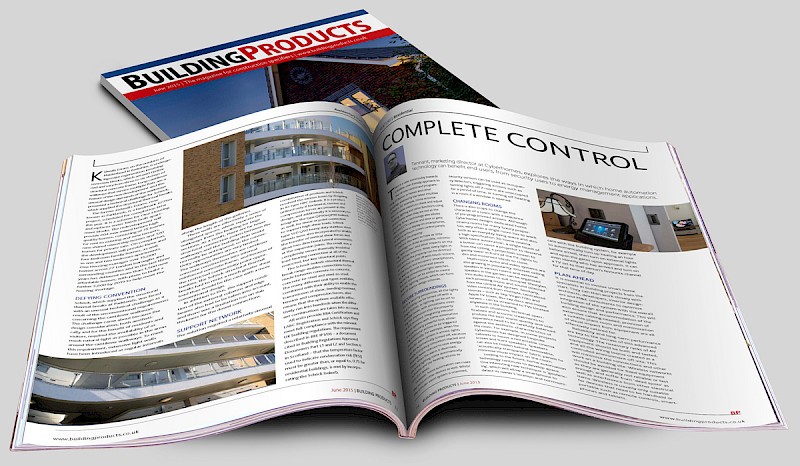06.09.2016
Cyberhomes wins ‘Best Home Cinema over £100,000’ Award
It’s been an award-winning year for UK smart home experts Cyberhomes....
Source: Building Products magazine
Tennant, marketing director at Cyberhomes, explores the ways in which home automation technology can benefit end users, from security uses to energy management applications.
There is a clear trend today towards a flexible, user-friendly approach to the remote control and programming of devices in homes and other buildings, enabled by the latest intuitive software. For example, home automation can allow owners to check and adjust heating, lighting and other functions using smartphones when they are not at the property. Smart technology also allows discreet CCTV cameras and door or gate entry systems to display on smartphones, as well as on touch-screen control panels throughout the property.
Owners also want to have as little technology on show as possible, minimising ‘wall clutter’ and other impacts on the look of their interiors. Now, every light in and around the property can be dimmed or switched on and off with touch-screens in the house and occupiers’ smartphones, as well as discreet local wall panels replacing conventional light switches. Pre-set scenes can be added to create specific lighting moods, which can form part of interior design schemes.

From a security perspective, all the lights in a building can be turned off with a single button, or lighting can be set to holiday mode, with simulations creating the impression that the property is still occupied.
Integrating intruder alarm systems with home automation is a particularly powerful tool, allowing additional actions to be triggered automatically. For example, when the intruder alarm system is armed, lights can be automatically turned off, vacation mode occupancy simulation started and heating levels reduced to save energy. Then, when the alarm is disarmed, an entry lighting scene automatically activates and the heating returns to comfort levels.
However, home automation can make the most of other devices as well. Whilst the intruder alarm system is unarmed, security sensors can be used as occupancy detectors, triggering actions such as turning lights off if rooms are unoccupied for a period of time, or turning off heating in a room if a window is opened.
There is also scope to change the character of a room with a sequence of pre-programmed actions.
Although Cyberhomes designs dedicated home cinema rooms for many luxury properties, very often a single room has to work both as an everyday living space and also a high-specification 3D home cinema. With home automation, a single touch of a button can cause a projector to descend from the ceiling, a projection screen to gently lower in front of the TV, lights to dim and motorised blinds to close.
Multi-room audio and video systems are also growing in popularity. Discreet ceiling speakers in various rooms and external speakers in the garden can be organised into audio zones to suit occupier lifestyles, each providing music and sound selected from the central AV system. Similarly, video content from multiple, centralised sources—such as Sky, Virgin TiVo and Apple TV boxes, Blu-ray discs and movie servers—can be streamed to TVs located anywhere in the building.
In such situations, technical specifications and acoustic treatments to produce the best sound quality and user experience need to be carefully balanced against the aesthetic characteristics of the room. For example, in some projects Cyberhomes has designed bespoke cabinets to house a retractable cinema screen and front speakers. Speakers can also be hidden behind removable, ‘acoustically-transparent’ fabric panels to minimise visual impact on the room.
Looking to the future, home automation technology continues to develop apace. One interesting new technique is ‘geofencing’, which will allow a smartphone to detect its owner’s location and communicate with the building system, for example to automatically turn up heating an hour before arrival, then turn on external lights and open the gates upon approach. It can even identify who has arrived and turn on a TV set to that person’s favourite channel for that time of day.
It is essential to involve smart home specialists in building projects from the start.
They can then work closely with architects, developers, interior designers and M&E consultants to optimise integration of the system with the overall building design and performance. This will also ensure that accommodation of the extensive cabling needed, provision of a suitable plant room and minimisation of visual impact from equipment are all effectively catered for.
Reliability and long-term performance are key to the success of this advanced technology. The necessary racks of AV equipment should be built and tested, and all the wiring looms created in a controlled environment off-site. This will minimise the connections and other work on a building site. Wireless networks should be avoided for fixed equipment as they are generally not reliable or fast enough, and suffer from ‘dead spots’ as well as interference from other electrical items. Wireless is usually only suitable for devices that need to be handheld or portable such as remote controls, smartphones and tablets.
See this feature in the June issue of Building Products
Building Products magazine and website